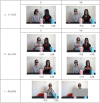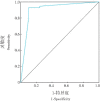[Machine learning algorithms for identifying autism spectrum disorder through eye-tracking in different intention videos]
- PMID: 38436312
- PMCID: PMC10921872
- DOI: 10.7499/j.issn.1008-8830.2309073
[Machine learning algorithms for identifying autism spectrum disorder through eye-tracking in different intention videos]
Abstract
Objectives: To investigate the differences in visual perception between children with autism spectrum disorder (ASD) and typically developing (TD) children when watching different intention videos, and to explore the feasibility of machine learning algorithms in objectively distinguishing between ASD children and TD children.
Methods: A total of 58 children with ASD and 50 TD children were enrolled and were asked to watch the videos containing joint intention and non-joint intention, and the gaze duration and frequency in different areas of interest were used as original indicators to construct classifier-based models. The models were evaluated in terms of the indicators such as accuracy, sensitivity, and specificity.
Results: When using eight common classifiers, including support vector machine, linear discriminant analysis, decision tree, random forest, and K-nearest neighbors (with K values of 1, 3, 5, and 7), based on the original feature indicators, the highest classification accuracy achieved was 81.90%. A feature reconstruction approach with a decision tree classifier was used to further improve the accuracy of classification, and then the model showed the accuracy of 91.43%, the specificity of 89.80%, and the sensitivity of 92.86%, with an area under the receiver operating characteristic curve of 0.909 (P<0.001).
Conclusions: The machine learning model based on eye-tracking data can accurately distinguish ASD children from TD children, which provides a scientific basis for developing rapid and objective ASD screening tools.
目的: 旨在探究孤独症谱系障碍(autism spectrum disorder, ASD)和正常发育(typically developing, TD)儿童在观看不同意图场景视频时的视觉感知差异,并通过机器学习算法,探索客观区分ASD和TD儿童的可行性。方法: 共纳入58名ASD儿童和50名TD儿童,观看包含联合意图和非联合意图的视频,使用儿童观看视频时在不同注视兴趣区的注视时长占比和注视次数占比作为原始特征指标,输入到分类器中构建分类模型,分析比较不同分类模型的分类准确率、灵敏度和特异度等指标。结果: 使用支持向量机、线性判别算法、决策树、随机森林和邻近算法(K=1、3、5、7)8种常见的分类器基于原始特征指标进行分类时,最高分类精度为81.90%。为进一步提高分类精度,采用特征重构方式,运用决策树分类器进行分类,分类模型的准确度高达91.43%,特异度为89.80%,灵敏度为92.86%,受试者操作特征曲线的曲线下面积为0.909(P<0.001)。结论: 采用眼动追踪数据构建的机器学习模型可精确地将ASD儿童与TD儿童区分开来,为开发快速客观筛查ASD的辅助工具提供科学依据。.
Keywords: Action understanding; Autism spectrum disorder; Child; Eye tracking; Joint intention; Machine learning.
Conflict of interest statement
所有作者声明无利益冲突。
Figures
Similar articles
-
Classification of Children With Autism and Typical Development Using Eye-Tracking Data From Face-to-Face Conversations: Machine Learning Model Development and Performance Evaluation.J Med Internet Res. 2021 Aug 26;23(8):e29328. doi: 10.2196/29328. J Med Internet Res. 2021. PMID: 34435957 Free PMC article.
-
Early identification of autism spectrum disorder based on machine learning with eye-tracking data.J Affect Disord. 2024 Aug 1;358:326-334. doi: 10.1016/j.jad.2024.04.049. Epub 2024 Apr 12. J Affect Disord. 2024. PMID: 38615846
-
Enhancing ensemble classifiers utilizing gaze tracking data for autism spectrum disorder diagnosis.Comput Biol Med. 2024 Nov;182:109184. doi: 10.1016/j.compbiomed.2024.109184. Epub 2024 Sep 30. Comput Biol Med. 2024. PMID: 39353297
-
A Review of Machine Learning Methods of Feature Selection and Classification for Autism Spectrum Disorder.Brain Sci. 2020 Dec 7;10(12):949. doi: 10.3390/brainsci10120949. Brain Sci. 2020. PMID: 33297436 Free PMC article. Review.
-
Assessment of the Autism Spectrum Disorder Based on Machine Learning and Social Visual Attention: A Systematic Review.J Autism Dev Disord. 2022 May;52(5):2187-2202. doi: 10.1007/s10803-021-05106-5. Epub 2021 Jun 8. J Autism Dev Disord. 2022. PMID: 34101081 Free PMC article.





